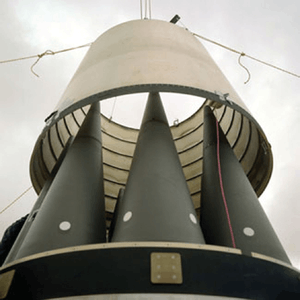W87
The W87 is an American thermonuclear missile warhead formerly deployed on the LGM-118A Peacekeeper ("MX") ICBM. 50 MX missiles were built, each carrying up to 10 W87 warheads in multiple independently targetable reentry vehicles, and were deployed from 1986 to 2005. Starting in 2007, 250 of the W87 warheads from retired Peacekeeper missiles were retrofitted onto much older Minuteman III missiles, with one warhead per missile.[1]
| W87 | |
|---|---|
 The Mk21 Re-entry Vehicles shown here for the LGM-118A Peacekeeper contain W87 warheads. | |
| Type | Nuclear bomb |
| Service history | |
| In service | 1986–present |
| Used by | United States |
| Production history | |
| Designer | Los Alamos National Laboratory |
| Designed | Mod 0: February 1982 Mod 1: November 1987 to July 1988, March 2019 to 2030 |
| Produced | Mod 0: July 1986 to December 1988 Mod 1: 2030 onwards |
| No. built | 525 |
| Variants | 2 |
| Specifications | |
| Mass | 400 pounds (180 kg) to 600 pounds (270 kg) |
Detonation mechanism | Contact, airburst |
| Blast yield | 300 kt (W87-0) 475 kt (W87-1) |
Description

Design of the W87 started in February 1982 at Lawrence Livermore National Laboratory and production of the warhead began in July 1986 and ended in December 1988.[2] Its design is reportedly somewhat similar to the W88, though that warhead was designed at Los Alamos National Laboratory. The weapons are part of a National Nuclear Security Administration nuclear weapons lifecycle program.[3]
The W87 design includes all modern safety features, including the insensitive high explosives LX-17 and PBX-9502 (primary component TATB), a fire-resistant pit, and advanced arming and fuzing safety features.
The original yield of the W87 was 300 kilotons, but has the announced ability to be upgraded to a yield of 475 kilotons, presumably by using more highly enriched uranium (HEU) in the fusion secondary stage tamper. It is not known if that upgrade was completely tested and ready to implement, or merely designed.
The exact dimensions of the W87 are classified, but it fits inside the Mk. 21 reentry vehicle, which is a cone with base diameter of 22 inches (56 cm) and a length of 69 inches (180 cm). The weight is believed to be between 440 and 600 pounds (200 and 270 kg).
Variants
In addition to the higher yield upgrade option described above, a specific variant W87 mod 1 (W87-1) entered Phase 3 development engineering and was assigned its type designation in November 1988.[2] This variant was intended for the MGM-134 Midgetman small ICBM missile and was intended to have the full 475 kiloton yield. The Midgetman and W87-1 were canceled in January 1992.
In 2019, the W87 mod 1 was selected to replace the W78 warhead deployed on all Minuteman III missiles not currently carrying the W87 mod 0. The new warhead will not be deployed onto Minuteman III, but instead be deployed on Minuteman III's replacement ICBM system Ground Based Strategic Deterrent. It is not clear if the new W87 mod 1 program is a continuation of the previous W87 mod 1 program, or if it uses any of the physics package developed in the previous W87 mod 1 program.[4]
Information released by the Department of Energy on the program states that it "has a similar primary design to the W87-0", which could be evidence that it is like the previous W87 mod 1 program in that it has a different or modified secondary to produce a higher yield. The DoE notes that the weapon is based on previously tested nuclear components.[4]
The first production warhead should be fielded by 2030.[4]
See also
References
- Kristensen, Hans M.; Norris, Robert S. (January 18, 2015). "US nuclear forces, 2015". Bulletin of the Atomic Scientists. 71 (2): 107–119. doi:10.1177/0096340215571913.
- Nuclear weapons labs (status report), University of California, 1989.
- "Fact Sheet: W87-1 Modification Program" (PDF). National Nuclear Security Administration. March 2019.
- "W87-1 Modification Program" (PDF). March 2019. Retrieved 2020-03-08.
Bibliography
- Cox Committee Report (the Report of the Select Committee on U.S. National Security and Military/Commercial Concerns with the People's Republic of China) (1999)